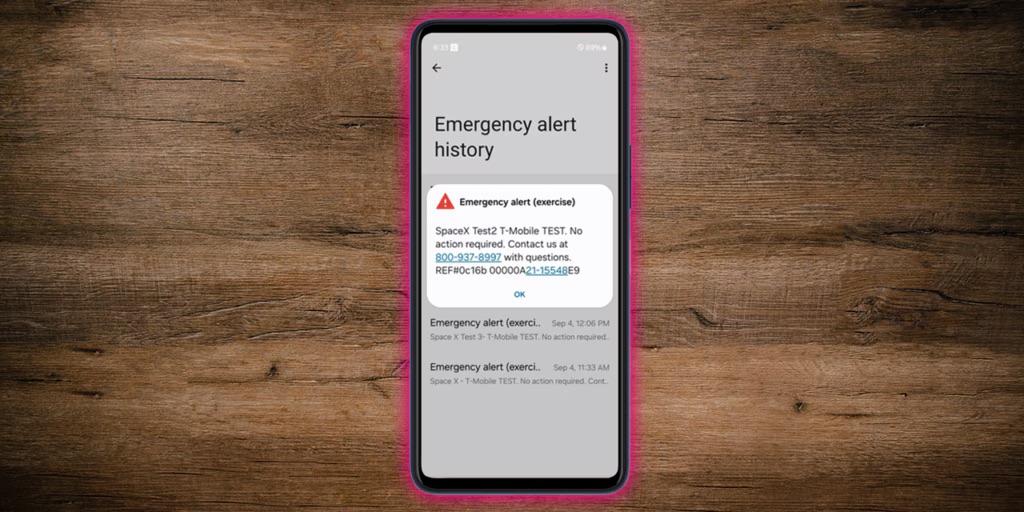T-Mobile Conducts the First Ever Wireless Emergency Alert Via Satellite
T-Mobile (NASDAQ:TMUS) has successfully conducted the first-ever wireless emergency alert (WEA) via satellite in the U.S. This breakthrough enables critical emergency alerts to reach 500,000+ square miles of land currently unreachable by earth-based cell towers. The test, conducted on September 5th, sent an alert 217 miles into space, where it was received by a Starlink direct-to-smartphone satellite and then broadcast to a geographic area on the ground.
This technology will benefit areas prone to natural disasters, such as the 2018 Camp Fire in Northern California, where lack of cellular coverage hindered emergency communications. T-Mobile and Starlink are currently testing satellite-to-smartphone service with over 175 satellites in low-earth orbit, with plans for beta testing before commercial launch.
T-Mobile (NASDAQ:TMUS) ha condotto con successo il primo allerta d'emergenza wireless (WEA) via satellite negli Stati Uniti. Questa innovazione permette di inviare avvisi critici in 500.000+ miglia quadrate di terreno attualmente irraggiungibili dalle torri di telefonia terrestre. Il test, effettuato il 5 settembre, ha inviato un avviso a 217 miglia nello spazio, dove è stato ricevuto da un satellite Starlink diretto a smartphone e successivamente trasmesso a una zona geografica a terra.
Questa tecnologia avrà benefici per le aree soggette a calamità naturali, come il Camp Fire nel Nord della California nel 2018, dove la mancanza di copertura cellulare ha ostacolato le comunicazioni di emergenza. T-Mobile e Starlink stanno attualmente testando il servizio satellite-a-smartphone con oltre 175 satelliti in orbita bassa terrestre, con piani per test beta prima del lancio commerciale.
T-Mobile (NASDAQ:TMUS) ha realizado con éxito la primera alerta de emergencia inalámbrica (WEA) a través de satélite en los EE. UU. Este avance permite que alertas críticas lleguen a 500,000+ millas cuadradas de territorio que actualmente no es accesible por torres de telefonía terrestre. La prueba, llevada a cabo el 5 de septiembre, envió una alerta a 217 millas en el espacio, donde fue recibida por un satélite Starlink directo a teléfonos inteligentes y luego transmitida a una zona geográfica en la tierra.
Esta tecnología beneficiará a áreas propensas a desastres naturales, como el Camp Fire de 2018 en el norte de California, donde la falta de cobertura celular obstaculizó las comunicaciones de emergencia. T-Mobile y Starlink están actualmente probando el servicio de satélite a smartphone con más de 175 satélites en órbita terrestre baja, con planes de pruebas beta antes del lanzamiento comercial.
T-Mobile (NASDAQ:TMUS)는 미국에서 최초로 위성을 이용한 무선 비상 경고(WEA)를 성공적으로 수행했습니다. 이 혁신은 현재 지상 기반 셀 타워로 도달할 수 없는 500,000+ 제곱마일의 지역에 중요한 비상 경고를 전할 수 있게 해줍니다. 9월 5일에 진행된 실험에서는 217마일의 거리로 경고를 전송했으며, 이는 스타링크 스마트폰 직송 위성에 의해 수신되고 지상 특정 지역으로 방송되었습니다.
이 기술은 2018년 북부 캘리포니아의 캠프 화재와 같은 자연 재해에 취약한 지역에 혜택을 줄 것입니다. 당시 통신 부족으로 비상 통신이 방해받았었습니다. T-Mobile과 Starlink는 175개 이상의 위성으로 저궤도에서 위성-스마트폰 서비스를 현재 테스트 중이며, 상업적 출시 전에 베타 테스트를 계획하고 있습니다.
T-Mobile (NASDAQ:TMUS) a réussi à effectuer la première alerte d'urgence sans fil (WEA) par satellite aux États-Unis. Cette avancée permet aux alertes d'urgence critiques d'atteindre 500 000+ miles carrés de terres actuellement inaccessibles par les tours cellulaires terrestres. Le test, effectué le 5 septembre, a envoyé une alerte à 217 miles dans l'espace, où elle a été reçue par un satellite Starlink directement connecté aux smartphones, puis diffusée dans une zone géographique au sol.
Cette technologie bénéficiera aux zones sujettes aux catastrophes naturelles, comme le Camp Fire de 2018 dans le nord de la Californie, où le manque de couverture cellulaire a entravé les communications d'urgence. T-Mobile et Starlink testent actuellement un service satellite-vers-smartphone avec plus de 175 satellites en orbite basse, avec des plans pour des tests bêta avant le lancement commercial.
T-Mobile (NASDAQ:TMUS) hat erfolgreich die erste drahtlose Notfallwarnung (WEA) über Satellit in den USA durchgeführt. Dieser Durchbruch ermöglicht es, dass kritische Notfallwarnungen 500.000+ Quadratmeilen von derzeit nicht erreichbarem Land durch terrestrische Mobilfunktürme erreichen. Der Test, der am 5. September durchgeführt wurde, sandte eine Warnung 217 Meilen ins All, wo sie von einem Starlink-Satelliten, der direkt an Smartphones sendet, empfangen und dann an ein geografisches Gebiet auf dem Boden übertragen wurde.
Diese Technologie wird Gebieten zugutekommen, die anfällig für Naturkatastrophen sind, wie zum Beispiel dem Camp Fire 2018 in Nordkalifornien, wo der Mangel an Mobilfunkabdeckung die Notrufkommunikation behindert hat. T-Mobile und Starlink testen derzeit den Satelliten-zu-Smartphone-Service mit über 175 Satelliten in niederer Erdumlaufbahn und planen Beta-Tests vor dem kommerziellen Start.
- First successful wireless emergency alert via satellite in the U.S.
- Expands emergency alert coverage to 500,000+ square miles of previously unreachable land
- Potential to save lives in areas prone to natural disasters
- Partnership with Starlink for satellite-to-smartphone service
- Over 175 direct-to-smartphone satellites already in low-earth orbit
- Service still in testing phase, not yet commercially available
Insights
T-Mobile's successful test of satellite-based Wireless Emergency Alerts (WEA) marks a significant leap in emergency communication technology. This breakthrough could potentially save countless lives by extending critical alerts to 500,000+ square miles of previously unreachable areas. The ability to send alerts via Starlink's 175+ low-earth orbit satellites addresses a important gap in current emergency systems, particularly in rural, mountainous, or sparsely populated regions.
The implications for disaster management are profound. As demonstrated by the 2018 Camp Fire example, this technology could have made a substantial difference in evacuation efforts and potentially reduced casualties. The speed of alert delivery - just seconds from initiation to reception - is particularly impressive and important in time-sensitive emergencies.
However, it's important to note that this is still in the testing phase. The success of the full-scale implementation will depend on factors such as satellite coverage consistency, system reliability during actual disasters and seamless integration with existing emergency alert infrastructures.
This innovation positions T-Mobile as a pioneer in satellite-based emergency communications, potentially boosting its market appeal and competitive edge. The universal nature of the service - working for customers of all carriers - could enhance T-Mobile's reputation and possibly lead to partnerships or revenue-sharing agreements with other telecom companies.
Investors should consider the long-term implications: this technology could open new revenue streams, particularly in rural areas where traditional infrastructure is cost-prohibitive. It may also lead to government contracts for emergency services. However, the initial investment and ongoing operational costs of this satellite network could impact short-term financials.
The market's reaction will likely be positive, given the potential for expanded coverage and new service offerings. This could translate to increased customer acquisition and retention, especially in underserved areas. However, the full financial impact will depend on the timeline for commercial launch and the pricing strategy for this new service.
BELLEVUE, WA / ACCESSWIRE / September 12, 2024 / T-Mobile
T-Mobile Starlink satellite-to-smartphone technology to bring critical emergency alerts to 500,000+ square miles of land currently unreachable with earth-based cell towers
Emergency alerts will work for everyone - even Verizon, AT&T and other wireless provider customers will receive critical emergency alerts
Hurricanes, tornadoes, fires - the type of catastrophic events that often trigger a wireless emergency alert - don't care about wireless coverage zones. Soon it won't matter.
Today, T-Mobile (NASDAQ:TMUS) announced that it successfully sent and received - for the first time ever in the U.S. - a wireless emergency alert (WEA) via satellite. The breakthrough opens up the 500,000 square miles of lightly populated, mountainous and/or uninhabitable land across the country to critical, life-saving emergency alerts.
"This is one of those days, as the CEO of a wireless company, that makes me pause for a moment and reflect on how technology advancements and the work we're doing is truly impacting life and death situations," said Mike Sievert, CEO, T-Mobile.
At 5:13 PM PT on Thursday, September 5th, T-Mobile initiated a test alert for a hypothetical evacuation notice. The alert was sent 217 miles into space where it was received by one of the more than 175 Starlink direct-to-smartphone satellites currently in low earth orbit that effectively function as cell towers in space. The alert was then broadcast to a geographic area impacted by the hypothetical evacuation notice and received by a T-Mobile smartphone.
In total, it took emergency operators just seconds to queue up an emergency message and deliver that message via Starlink satellites to users on the ground.
The life-saving benefits of satellite-enabled WEAs are immense. Take the 2018 Camp Fire in Northern California as an example. The fire, which ultimately burned more than 150,000 acres, forced the evacuation of 52,000 people, destroyed 19,000 structures including most of the city of Paradise and, most devastatingly, took 86 lives, erupted in the rural Sierra Nevada mountains.
Those who lived, worked or played off the cellular network grid - relatively common in lightly populated areas with significant elevation changes - had no access to emergency alerts due to lack of wireless service coverage. The fire also took out a reported 17 cell towers on the first day of the fire and 66 total during the first two weeks of the blaze making communications - with first responders or loved ones - nearly impossible for many.
T-Mobile and Starlink, with more than 175 direct-to-smartphone satellites currently in low-earth orbit, are currently testing satellite-to-smartphone service. Additional SpaceX launches are scheduled over the coming months to add more satellites to the current constellation, further blanketing the country with wireless coverage. As that happens, T-Mobile intends to beta test the service before launching it commercially.
Follow @TMobileNews on X, formerly known as Twitter, to stay up to date with the latest company news.
###
About T-Mobile
T-Mobile US, Inc. (NASDAQ: TMUS) is America's supercharged Un-carrier, delivering an advanced 4G LTE and transformative nationwide 5G network that will offer reliable connectivity for all. T-Mobile's customers benefit from its unmatched combination of value and quality, unwavering obsession with offering them the best possible service experience and undisputable drive for disruption that creates competition and innovation in wireless and beyond. Based in Bellevue, Wash., T-Mobile provides services through its subsidiaries and operates its flagship brands, T-Mobile, Metro by T-Mobile and Sprint. For more information please visit: https://www.t-mobile.com
Media Contacts
T-Mobile US, Inc. Media Relations
MediaRelations@t-mobile.com
Investor Relations Contact
T-Mobile US, Inc.
investor.relations@t-mobile.com
https://investor.t-mobile.com

View additional multimedia and more ESG storytelling from T-Mobile on 3blmedia.com.
Contact Info:
Spokesperson: T-Mobile
Website: https://www.3blmedia.com/profiles/t-mobile
Email: info@3blmedia.com
SOURCE: T-Mobile
View the original press release on accesswire.com







